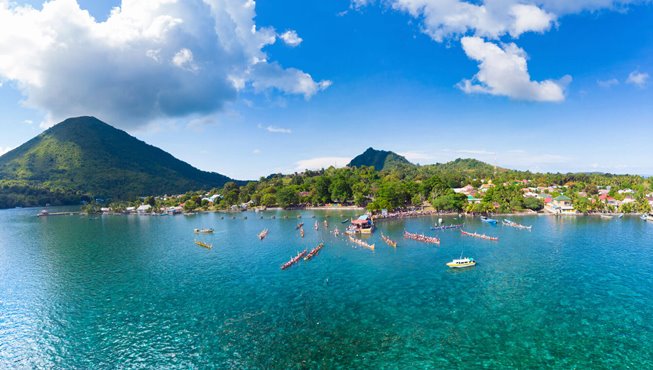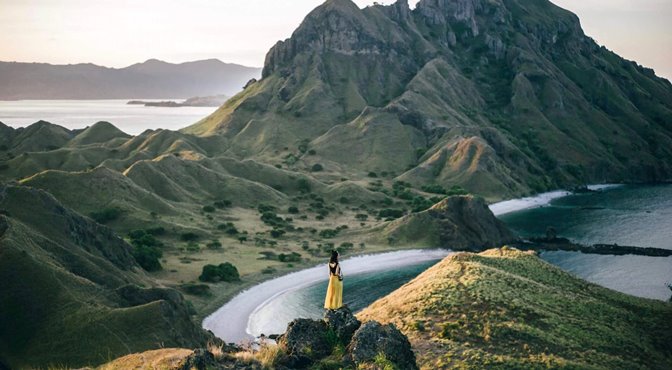
Raja Ampat islands review
Raja Ampat is a cluster of pristine islands and islets in the remote part of Indonesia that harbors the world’s most spectacular array of biodiversity — both on land and underwater. The geography, the wildlife, the diving, the culture, and the hospitality of people are all legendary. The diversity of marine life is staggering and too long to attempt to list. Thanks to the Indonesian through-flow, the water in Raja Ampat is as clear as gin offering diving and snorkeling grounds beyond expectations. There are hundreds of lookouts and unbelievable viewpoints to trek to while exploring Raja Ampat. This eye-opening region is genuinely the last untouched paradise on Earth.
Those who have visited Raja Ampat have dubbed it an “untouched paradise,” implicating the area’s propensity for tranquility, discovery, and unfiltered awe. Raja Ampat comprises rocky outcrops which protrude from calm, turquoise water and a unique labyrinth of more than 1,500 islands. The karst topography is characterized by caves, mushroom islands, cones, fissures and ridges, eroded by winds and tides over time. The limestone islands are covered with lush rainforest right down to the water’s edge. The area is a captivating melange of natural wonders, both above and below the water.
Of the 533 types of hard coral in the world, 75% are found in Raja Ampat. Swimming around these islands is an unfiltered experience of nature’s most beautiful aquarium. Raja Ampat is home to 1300 species of fish (and biologists are still discovering new species regularly), 6 out of 7 sea turtle species, and 15 species of mammals. Raja Ampat’s biodiversity on land is every bit as rich, hiding endemic Birds of Paradise and elusive cuscus. There are rock islets amidst crystal waters, untouched hills covered in orchids, and limestone cliffs jutting around hidden bays – it is a rugged, raw, and utterly unique experience.
- AIRPORT Sorong
- BEST TIME TO VISIT Nov - May
North
See all (8)Central
See all (15)South
See all (12)Yacht
See all (9)Holiday
Why visit Raja Ampat
Where is Raja Ampat
The Raja Ampat islands are located in the remote West Papua province of Indonesia, right at the tip of the Bird’s Head Peninsula, and perceivable from 800km away in space. The Bird’s Head Peninsula lines the north-western end of the island of New Guinea. To the east is beautiful Cenderawasih Bay, and to the west is Waigeo island of Raja Ampat. In contrast, Batanta, Salawati, and Misool islands lie just off the northwest tip.
Sorong is the main gateway to Raja Ampat, as it is the closest Indonesian town with an airport. From Sorong harbor, you can take a private boat to Wasai on the island of Waigeo, which is the other main launch point for homestay and hotel pickup. We recommend booking a speed boat sea transfer, an informative boat tour, or luxurious yacht holiday through Islander as it is the most efficient, versatile, and all-inclusive way to travel through Raja Ampat.
Travel from Sorong to Kri island, Piaynemo, Arborek, Wayag, Equator islands, and back to Gam island and Waigeo. Vacationers can visit secret bays, cross the equator while snorkeling, dive with friendly manta rays, enchanting pygmy seahorses, exotic sharks, and rare dolphins! While you’re at it, learn how to cultivate precious pearls with locals and after, throw a cocktail party or two exclusively on Islander’s private boat. Going on an adventure has never been easier with a professional team dedicated to tailoring your sailing experience.
Best time in Raja Ampat
There is no “off-season” as far as climate and underwater conditions are concerned in Raja Ampat. However, your best chance of perfect conditions lies between mid-October and mid-December, with the welcoming ocean for sailing holidays up until April-May. The rainy season ranges from mid-June to mid-September. Nevertheless, it does not rain every day, and underwater visibility is not affected. It is also essential to consider that Raja Ampat is an ultimate tropical destination. Therefore, mild rainfall can occur at any time for a short period, and this affects the year-round rainfall averages. You will never experience heavy rain for sustained periods, so any time of year is a good time to visit Raja Ampat.
Culture of Raja Ampat
Raja Ampat translates to “Four Kings,” which represents four of Raja Ampat’s largest islands: Misool, Waigeo, Salawati, and Batanta. However, there are anywhere between 610 and 1,500 different islands to explore in the Raja Ampat archipelago (depending on your definition of an island). Only 35 of all islands are inhabited in Raja Ampat by a total of 50,000 people. The original inhabitants of Raja Ampat are called the Papuans. They are one of the oldest and most genetically diverse human populations in the world. Communities in Raja Ampat primarily make their living from sustainable fishing and pearling, with around 20 unique villages in the region spanning 40,000 square kilometers.
No matter which activity you are passionate about, you may be the only person in the world to experience certain traditions here in Mother Nature’s hidden crown jewel. The local saying goes, it takes a village to raise a child. From an early age, the kids watched over by the nearest oldest, learning how to run the land and swim the open sea. The kids learn early in life that they are not children of two parents, but a child of the village. So if the child grows up and goes out to sea in peace, he will know that his own children will always be cared for by the village. Forever in his heart, the kind of freedom the village gave is pure and simple.
The paradise of Raja Ampat is quite some distance from the inhabited world. The main town hubs to stay are Sorong on the mainland and Waisai on Waigeo island. You can also find many home-stay locations spread out across this massive archipelago. But if you want to make the most of your Raja Ampat holiday, we recommend exploration at your own pace on a private yacht that you can charter through Islander. There is nothing like the comfort of returning to a home base that travels with you on your many adventures.
Birds of Paradise in Raja Ampat
Bird of Paradise is a rare and remarkable species that are commonly associated with Raja Ampat because, well, it is a paradise. There are more than three dozen species of birds-of-paradise in Raja Ampat, including many endemic species. Most of the Birds of Paradise are distinguished by striking colors and bright plumage of yellow, blue, scarlet, and green. These colors identify them as some of the world’s most dramatic and attractive birds. They also carry out strange habits. First filmed in 1996, David Attenborough captured footage of this unique species by dropping leaves on the forest floor, irritating the bird so much that it came down and cleared the leaves away with its beak.
On the islands of Gam, Waigeo, Batanta and Salawati, you may spot the dancing Red Bird-of-Paradise, Wilson’s Bird-of-Paradise, and Glossy-mantled Manucode. On Batanta and Salawati islands, there are also King Bird-of-Paradise, Twelve-wired Bird-of-Paradise, Lesser Bird-of-Paradise, Magnificent Bird-of-Paradise, Magnificent Riflebird, and Trumpet Manucode.
How to reach Raja Ampat from Jakarta
From Jakarta, take a direct flight to Sorong, which will take around 4 hours. You will arrive at the only hub from where you can commence your exploration of the Raja Ampat archipelago. You can choose to stay in numerous homestays or explore little by joining various overnight trips from Sorong. The ultimate way to experience the beauty of Raja Ampat is by chartering a yacht with Islander from Sorong and sailing paradise in absolute privacy and most comfort.
How to reach Raja Ampat from Singapore
From Singapore, catch a flight to Sorong via Manado (Indonesia). Once in Sorong, you can either start from Sorong harbor or venture towards Waisai by ferry or speedboat to begin your exploration of Raja Ampat. From both Sorong harbor or Waisai, you can take any of Islander’s speed boats, boat tours, or luxpeditions onboard the most beautiful yachts in Indonesia.
















































